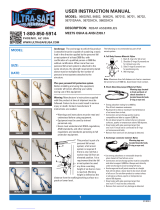
8
1.0 APPLICATIONS
1.1 PURPOSE: DBI-SALA full body harnesses are to be used as
components in personal fall arrest, restraint, work positioning, or
rescue systems. See Figures 1, 2, 3, and 4 for harness styles.
Harnesses included in this manual are full body harnesses and
meet ANSI Z359.1, OSHA, and CSA Z259.10 requirements. See
Figure 5 for application illustrations.
• Full body harnesses with Kevlar web should be used when
working with tools, materials, or environments of high
temperature (foundries, chemical manufacturing, steel
fabrication, emergency rescue services, re services, welders,
oil industry, nuclear industry, explosives).
• Harnesses with PVC coated hardware should be used when
working in explosive or electrically conductive environments, or
where surfaces must be protected from the hardware.
• Harnesses with high visibility webbing should be used when
increased visibility of the user is required.
A. PERSONAL FALL ARREST: The full body harness
is used as a component of a personal fall arrest
system. Personal fall arrest systems typically
include a full body harness and a connecting
subsystem (energy absorbing lanyard). Maximum
arresting force must not exceed 1,800 lbs (8
kN).For fall protection applications connect the
fall arrest subsystem (example: lanyard, SRL,
energy absorber, etc.) to the D-ring or attachment
element on your back, between your shoulder
blades.
B. WORK POSITIONING: The full body harness
is used as a component of a work positioning
system to support the user at a work position.
Work positioning systems typically include a full
body harness, positioning lanyard, and a back-up
personal fall arrest system. For work positioning
applications, connect the work positioning
subsystem (example: lanyard, Y-lanyard, etc.)
to the lower (hip level) side or belt mounted
work positioning attachment anchorage elements
(D-rings). Never use these connection points for
fall arrest.






















